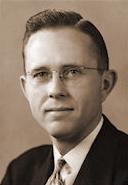Eugene Nida
From Textus Receptus
| Line 1: | Line 1: | ||
| - | [[Image: Eugene Nida.jpg|thumb|150px | + | [[Image: Eugene Nida.jpg|thumb|150px]] |
'''Eugene A. Nida''' (born November 11, 1914, in Oklahoma City, Oklahoma) is the developer of the [[dynamic equivalence|dynamic-equivalence]] [[Bible translation]] theory. Nida has influenced many against sound biblical texts encouraging them to follow corrupt manuscripts and bible versions. | '''Eugene A. Nida''' (born November 11, 1914, in Oklahoma City, Oklahoma) is the developer of the [[dynamic equivalence|dynamic-equivalence]] [[Bible translation]] theory. Nida has influenced many against sound biblical texts encouraging them to follow corrupt manuscripts and bible versions. | ||
Revision as of 10:58, 6 April 2011
Eugene A. Nida (born November 11, 1914, in Oklahoma City, Oklahoma) is the developer of the dynamic-equivalence Bible translation theory. Nida has influenced many against sound biblical texts encouraging them to follow corrupt manuscripts and bible versions.
Contents |
Life
Eugene Albert Nida was born in Oklahoma City, Oklahoma, on November 11 1914. Nida became a Christian at a young age, when he responded to the altar call at his church “to accept Christ as my Saviour.”
He graduated summa cum laude from the University of California in 1936. After graduating he attended Camp Wycliffe, where Bible translation theory was taught. He ministered for a short time among the Tarahumara Indians in Mexico, until health problems due to an inadequate diet and the high altitude forced him to leave. Sometime around this timeframe Nida became a founding charter member of Wycliffe Bible Translators, a sister organization of the Summer Institute of Linguistics.
In 1937, Nida undertook studies at the University of Southern California, where he obtained a Master’s Degree in New Testament Greek in 1939. In that same year Eugene Nida became interim pastor of Calvary Church of Santa Ana, CA, after the founding pastor resigned in 1939. In spite of his conservative background, in later years Nida became increasingly ecumenical and New Evangelical in his approach.
In 1943 Nida received his Ph.D. in Linguistics from the University of Michigan, he was ordained as a Baptist minister, and married Althea Lucille Sprague. The couple remained married until Althea Sprague Nida's death in 1993. In 1997 Nida married Dr. Elena Fernadez, a translator and interpreter.
Nida retired in the early 1980s and currently lives in Brussels, Belgium.
Career
In 1943 Dr. Nida began his career as a linguist with the American Bible Society (ABS). He was quickly promoted to Associate Secretary for Versions, then worked as Executive Secretary for Translations until his retirement.
Nida was instrumental in engineering the joint effort between the Vatican and the United Bible Societies (UBS) to produce cross-denominational Bibles in translations across the globe. This work began in 1968 and was carried on in accordance with Nida's translation principle of Functional Equivalence.
Translation and Linguistic Theories
Eugene Nida has been a pioneer in the fields of translation theory and linguistics.
His Ph.D. dissertation, A Synopsis of English Syntax, was the first full-scale analysis of a major language according to the "immediate-constituent" theory.
His most notable and most controversial contribution to translation theory is Dynamic Equivalence, also known as Functional Equivalence. This approach to translation aims to reproduce the intention of the original text in the translation, rather than reproducing the actual words of the original. For more information, see "Dynamic and formal equivalence."
Nida also developed the "componential-analysis" technique, which split words into their components to help determine equivalence in translation (e.g. "bachelor" = male + unmarried). This is, perhaps, not the best example of the technique, though it is the most well-known.
Works
Published Works include the following:
- Linguistic Interludes - (Glendale, CA: Summer Institute of Linguistics, 1944 (Revised 1947))
- The Bible Translator - (Journal founded and edited by Dr. Nida (retired), 1949- )
- Morphology: The Descriptive Analysis of Words - (Univ. of Michigan Press, 1949)
- Message and Mission - (Harper, 1960)
- Customs, Culture and Christianity - (Tyndale Press, 1963)
- Toward a Science of Translating - (Brill, 1964)
- Religion Across Cultures - (Harper, 1968)
- The Theory and Practice of Translation - (Brill, 1969, with C.R. Taber)
- Language Structure and Translation: Essays - (Stanford University Press, 1975)
- From One Language to Another - (Nelson, 1986, with Jan de Waard)
- The Greek-English Lexicon of the New Testament Based on Semantic Domains - (UBS, 1988, with Louw)
Bibliography relating to Nida
- Ma, H. J. 2003. A study of Nida’s translation theory. Beijing: Teaching and Research Press.
- Stine, Philip. 2005. Let the Words Be Written: The Lasting Influence of Eugene A. Nida. Brill Academic Publishers.
- George, Calvin. The History of the Reina-Valera 1960 Spanish Bible, Morris Publishing, 2004. (Contains a lengthy chapter about Nida's life and religious beliefs) Still in print and available through http://en.literaturabautista.com/node/22

